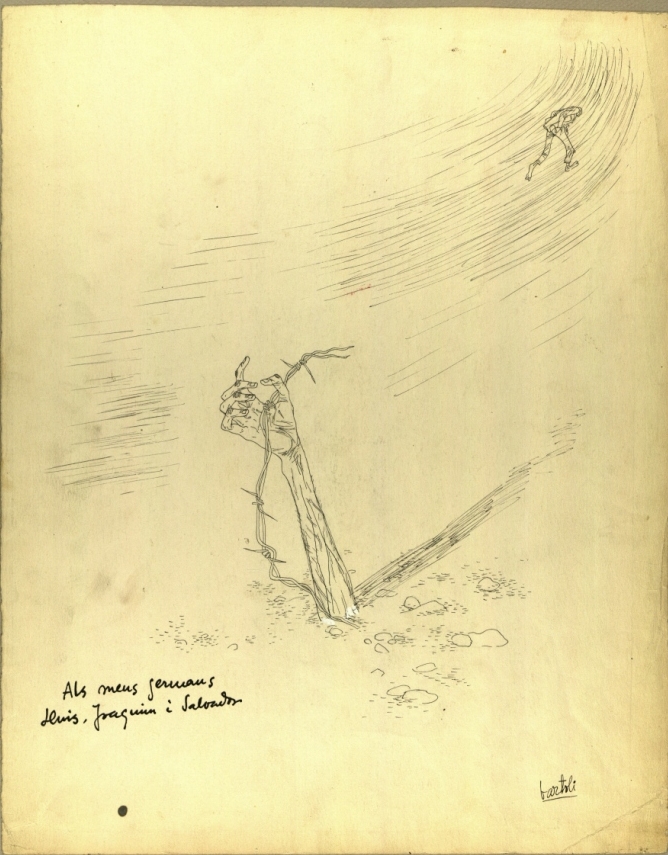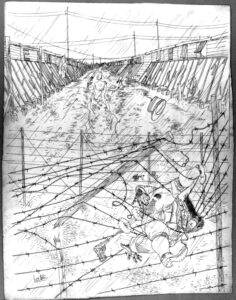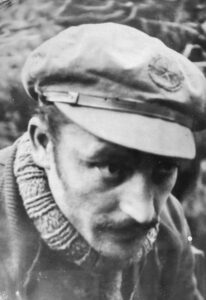French Exhibit Features Work by Josep Bartolí, Exiled Spanish Artist
On September 23, the Camp de Rivesaltes Memorial in southern France celebrated the opening night of “The colors of exile,” an exhibit honoring the life and work of Josep Bartolí, the Catalan artist and anti-fascist activist. The show, which will be up until September 2022, features over 150 works by Bartolí. It follows on the heels of a much-acclaimed—and Golden-Palm-winning—animated film, Josep, based on the artist’s experiences in the French detention camps hastily erected in 1939 to contain tens of thousands of Spanish Republican refugees. Directed by the designer Aurel, the film was screened at the opening night of the exhibit, poignantly and hauntingly projected outside among the ruins of the camp barracks.
Born in 1910 in Barcelona, Josep Bartolí was a cartoonist and caricaturist. A fervent defender and soldier for the Republic during the Civil War, in 1939, he found himself interned in the camps in the south of France, including those of Saint-Cyprien and Bram. After a long journey and escape from a train to Dachau, the artist found refuge in Mexico, where he was offered asylum and found fellowship with Diego Rivera, Frida Kahlo, and their circle. It was in Mexico that he published—with text from the journalist Narcís Molins Fabrega Campos de concentración 1939-1940—his iconographic testimony of his life in the camps. Bartolí later moved to New York, where he joined Rothko, Pollock, and Kline in the “10th Street Group.”
Curated by Bartolí’s nephew Georges Bartolí, the exhibit draws from the archive of Bartolí works recently donated to Rivesaltes by the artist’s widow. It follows his itinerary as a Republican fighter, a political painter, and visual chronicler of the Spanish Civil War; the Republican exodus; and the horrors of Francoism. Selections from the exhibit also comment on his commitment to fighting racism and injustice during his long exile in the USA.
For Josep Bartolí, the exhibit states, “drawing was a necessity, his work of resistance” Most arresting among his remarkably diverse selection of works on display are the pieces that chronicle the end of the civil war in Spain, the defeat of the Republic, exile into France, and the horrors and brutality of the French internment camps on the beaches of Argelès, Barcarès and St., Cyprien. These black and white sketches penciled in situ, exquisitely detailed and precise, are an important contribution to the history of the Republican internments in France. Along with the famous photographs taken by Robert Capa in 1939, Bartolí’s angry and ironic drawings mark a defining moment in the history of graphic reporting.
The exhibit is not limited representations of the concentration camp. Bold colors and oil paints made their appearance in Bartolí’s work after 1952, which feature bullfighting, mass culture, racial violence, war, and hunger, as Bartolí denounces the machismo and the racism prevalent in American society in the 1950s and 1960s.
ALBA board member Gina Herrmann teaches at the University of Oregon.
















The life of this Catalan anti-fascist and revolutionary cartoonist is really exciting.
In 2020 was released the film ‘Josep’, about the life of Josep Bartolí, the war, his struggle at the front with different units, including the International Brigades, his exile and passage through the concentration camps, his life after World War II, the relationship with characters like Frida Kahlo
https://en.wikipedia.org/wiki/Josep_(film)
The life of this Catalan anti-fascist and revolutionary cartoonist is really exciting.
In 2020 was released the film ‘Josep’, about the life of Josep Bartolí, the war, his struggle at the front with different units, including the International Brigades, his exile and passage through the concentration camps, his life after World War II, the relationship with characters like Frida Kahlo…
https://en.wikipedia.org/wiki/Josep_(film)